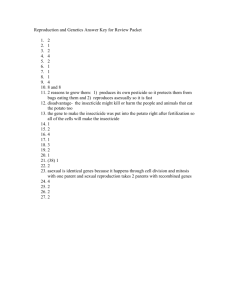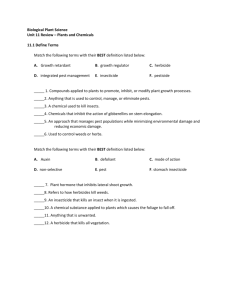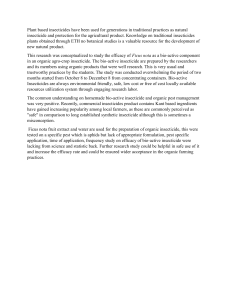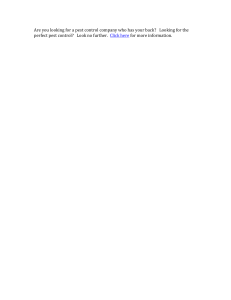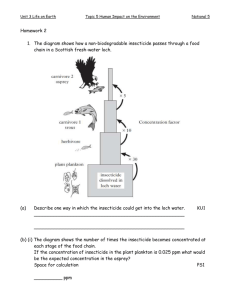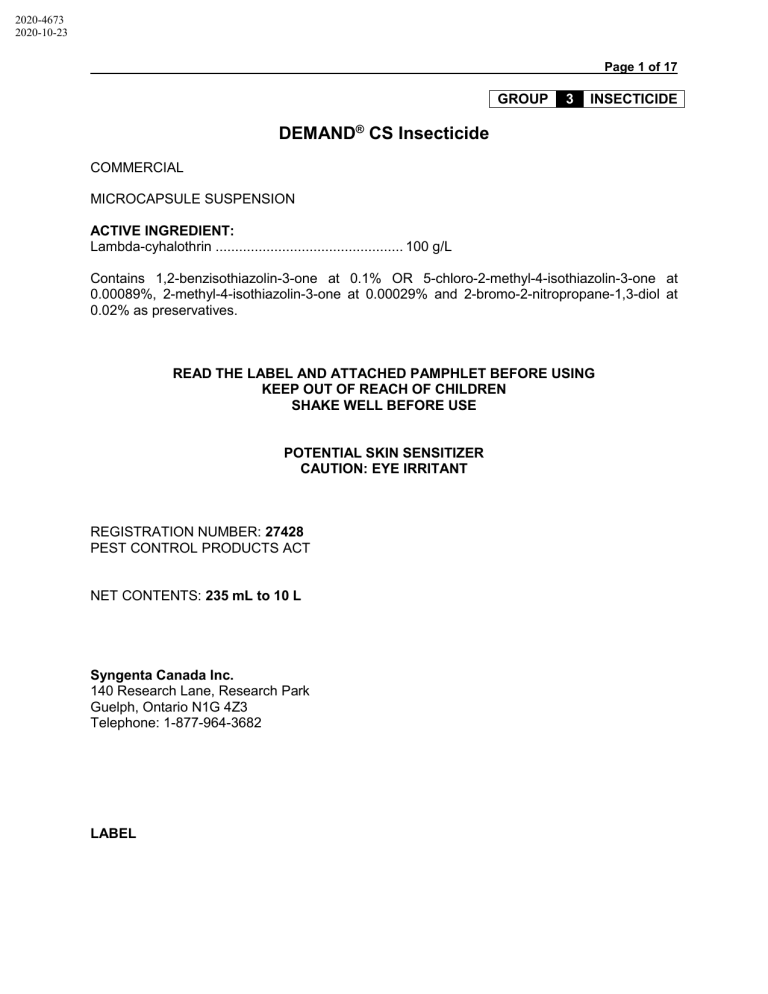
2020-4673 2020-10-23 Page 1 of 17 GROUP 3 INSECTICIDE DEMAND® CS Insecticide COMMERCIAL MICROCAPSULE SUSPENSION ACTIVE INGREDIENT: Lambda-cyhalothrin ................................................ 100 g/L Contains 1,2-benzisothiazolin-3-one at 0.1% OR 5-chloro-2-methyl-4-isothiazolin-3-one at 0.00089%, 2-methyl-4-isothiazolin-3-one at 0.00029% and 2-bromo-2-nitropropane-1,3-diol at 0.02% as preservatives. READ THE LABEL AND ATTACHED PAMPHLET BEFORE USING KEEP OUT OF REACH OF CHILDREN SHAKE WELL BEFORE USE POTENTIAL SKIN SENSITIZER CAUTION: EYE IRRITANT REGISTRATION NUMBER: 27428 PEST CONTROL PRODUCTS ACT NET CONTENTS: 235 mL to 10 L Syngenta Canada Inc. 140 Research Lane, Research Park Guelph, Ontario N1G 4Z3 Telephone: 1-877-964-3682 LABEL Page 2 of 17 NOTICE TO USER This pest control product is to be used only in accordance with the directions on the label. It is an offence under the Pest Control Products Act to use this product in a way that is inconsistent with the directions on the label. FIRST AID IN CASE OF POISONING, contact a physician or a poison control centre IMMEDIATELY. Take container, label or product name and Pest Control Product Registration Number with you when seeking medical attention. If swallowed, call a poison control centre or doctor IMMEDIATELY for treatment advice. Do not induce vomiting unless told to do so by a poison control centre or doctor. Do not give any liquid to the person. Do not give anything by mouth to an unconscious person. If on skin or clothing, take off contaminated clothing. Rinse skin IMMEDIATELY with plenty of water for 15 – 20 minutes. Call a poison control centre or doctor for treatment advice. If in eyes, hold eye open and rinse slowly and gently with water for 15 – 20 minutes. Remove contact lenses, if present, after the first 5 minutes, then continue rinsing eye. Call a poison control centre or doctor for treatment advice. If inhaled, move person to fresh air. If person is not breathing, call 911 or an ambulance, then give artificial respiration, preferably by mouth-to-mouth, if possible. Call a poison control centre or doctor for further treatment advice. TOXICOLOGICAL INFORMATION Contains petroleum symptomatically. distillates. Vomiting may cause aspiration pneumonia. Treat PRECAUTIONS KEEP OUT OF REACH OF CHILDREN AND ANIMALS. Vacate premises during application and keep all persons, pets and animals out of treated areas until surfaces are dry. Keep unused product in original container tightly closed, locked up and away from food. May irritate eyes. DEMAND® CS Insecticide is a potential skin sensitizer. In case of exposure to skin or face or other sensitive areas, some individuals may feel a tingling or numbness. This is a transitory effect and does not cause harm to skin. Avoid splashing in eyes or on skin, particularly the face. If hands are contaminated, wash with soap and water before touching other areas of skin. Personal Protective Equipment (PPE): When applying this product, workers should wear Page 3 of 17 long pants, long-sleeved shirts, and chemical resistant boots and gloves. In addition, during mixing, loading, clean-up and repair activities, workers must also wear chemical resistant gloves, safety goggles or a face shield. Avoid touching face with contaminated gloves or clothing. Wash gloves before removal. Wash protective equipment with soap and water after each use and separate from household laundry. When making an application to vinyl or wooden surfaces, treat a small area and allow to dry. Some types of vinyl or wooden surfaces, particularly if aged, may show some staining after application of DEMAND CS Insecticide. DO NOT apply this product in any room being used as living, eating, sleeping or recovery area by patients, the elderly, or infirm when they are in the room. DO NOT apply this product to edible growing crops or stored raw agricultural commodities used for food or feed. DO NOT allow applications to contact water inhabited by fish, such as in aquariums and ornamental fish ponds that are located in/around structures being treated. ENVIRONMENTAL PRECAUTIONS This product is very toxic to fish and aquatic organisms. It also contains a petroleum distillate, which is moderately to highly toxic to aquatic organisms. DO NOT contaminate ponds, lakes, streams or rivers or any bodies of water by direct application, during sprayer filling or rinsing operations or while spraying. Drift and runoff from treated areas may be hazardous to aquatic organisms in neighbouring areas. When making applications, care should be used to avoid exposure of household pets, particularly fish and reptile pets. This product is highly toxic to bees. DO NOT apply when weather conditions favour drift from the target area. STORAGE Store in a cool, well ventilated area away from foodstuffs and out of the reach of children and animals. Store above 0°C. Shake well before use. SPILL CLEANUP Wear appropriate protective equipment (gloves, glasses, apron) when attempting to clean up the spill. If the container is leaking, secure leak and place the container into a drum or heavy gauge plastic bag. Contact Syngenta Canada Inc. at 1-800-327-8633 (FASTMED) for further information. For spills and leaks - contain the liquid with dikes of inert material (soil, clay, kitty litter, etc.). Absorb the spill onto inert material and shovel into a sealable waste container. On hard surfaces - sprinkle spill area with detergent and scrub in a small quantity of water with a coarse broom. Let stand 10 minutes then absorb onto an inert material and shovel into the waste container. Page 4 of 17 On soil - remove the top 15 cm of soil in the spill area and replace with fresh soil. Dispose of all waste including scrub brush in accordance with provincial requirements. DISPOSAL For information on disposal of unused, unwanted product, contact the manufacturer or the provincial regulatory agency. Contact the manufacturer and the provincial regulatory agency in case of a spill, and for clean-up of spills. CONTAINER DISPOSAL: Do not reuse this container for any purpose. This is a recyclable container, and is to be disposed of at a container collection site. Contact your local distributor/dealer or municipality for the location of the nearest collection site. Before taking the container to the collection site: 1. Triple- or pressure-rinse the empty container. Add the rinsings to the spray mixture in the tank. 2. Make the empty, rinsed container unsuitable for further use. If there is no container collection site in your area, dispose of the container in accordance with provincial requirements. IN CASE OF EMERGENCY INVOLVING A MAJOR SPILL, FIRE OR POISONING, CALL 1-800-327-8633 (FASTMED) DEMAND® is a trademark of a Syngenta Group Company. Page 5 of 17 GROUP 3 INSECTICIDE DEMAND® CS Insecticide COMMERCIAL MICROCAPSULE SUSPENSION ACTIVE INGREDIENT: Lambda-cyhalothrin ................................................ 100 g/L Contains 1,2-benzisothiazolin-3-one at 0.1% OR 5-chloro-2-methyl-4-isothiazolin-3-one at 0.00089%, 2-methyl-4-isothiazolin-3-one at 0.00029% and 2-bromo-2-nitropropane-1,3-diol at 0.02% as preservatives. READ THE LABEL AND ATTACHED PAMPHLET BEFORE USING KEEP OUT OF REACH OF CHILDREN SHAKE WELL BEFORE USE POTENTIAL SKIN SENSITIZER CAUTION: EYE IRRITANT REGISTRATION NUMBER: 27428 PEST CONTROL PRODUCTS ACT Syngenta Canada Inc. 140 Research Lane, Research Park Guelph, Ontario N1G 4Z3 Telephone: 1-877-964-3682 PAMPHLET Page 6 of 17 NOTICE TO USER This pest control product is to be used only in accordance with the directions on the label. It is an offence under the Pest Control Products Act to use this product in a way that is inconsistent with the directions on the label. FIRST AID IN CASE OF POISONING, contact a physician or a poison control centre IMMEDIATELY. Take container, label or product name and Pest Control Product Registration Number with you when seeking medical attention. If swallowed, call a poison control centre or doctor IMMEDIATELY for treatment advice. Do not induce vomiting unless told to do so by a poison control centre or doctor. Do not give any liquid to the person. Do not give anything by mouth to an unconscious person. If on skin or clothing, take off contaminated clothing. Rinse skin IMMEDIATELY with plenty of water for 15 – 20 minutes. Call a poison control centre or doctor for treatment advice. If in eyes, hold eye open and rinse slowly and gently with water for 15 – 20 minutes. Remove contact lenses, if present, after the first 5 minutes, then continue rinsing eye. Call a poison control centre or doctor for treatment advice. If inhaled, move person to fresh air. If person is not breathing, call 911 or an ambulance, then give artificial respiration, preferably by mouth-to-mouth, if possible. Call a poison control centre or doctor for further treatment advice. TOXICOLOGICAL INFORMATION Contains petroleum symptomatically. distillates. Vomiting may cause aspiration pneumonia. Treat PRECAUTIONS KEEP OUT OF REACH OF CHILDREN AND ANIMALS. Vacate premises during application and keep all persons, pets and animals out of treated areas until surfaces are dry. Keep unused product in original container tightly closed, locked up and away from food. May irritate eyes. DEMAND® CS Insecticide is a potential skin sensitizer. In case of exposure to skin or face or other sensitive areas, some individuals may feel a tingling or numbness. This is a transitory effect and does not cause harm to skin. Avoid splashing in eyes or on skin, particularly the face. If hands are contaminated, wash with soap and water before touching other areas of skin. Personal Protective Equipment (PPE): When applying this product, workers should wear Page 7 of 17 long pants, long-sleeved shirts, and chemical resistant boots and gloves. In addition, during mixing, loading, clean-up and repair activities, workers must also wear chemical resistant gloves, safety goggles or a face shield. Avoid touching face with contaminated gloves or clothing. Wash gloves before removal. Wash protective equipment with soap and water after each use and separate from household laundry. When making an application to vinyl or wooden surfaces, treat a small area and allow to dry. Some types of vinyl or wooden surfaces, particularly if aged, may show some staining after application of DEMAND CS Insecticide. DO NOT apply this product in any room being used as living, eating, sleeping or recovery area by patients, the elderly, or infirm when they are in the room. DO NOT apply this product to edible growing crops or stored raw agricultural commodities used for food or feed. DO NOT allow applications to contact water inhabited by fish, such as in aquariums and ornamental fish ponds that are located in/around structures being treated. ENVIRONMENTAL PRECAUTIONS This product is very toxic to fish and aquatic organisms. It also contains a petroleum distillate, which is moderately to highly toxic to aquatic organisms. DO NOT contaminate ponds, lakes, streams or rivers or any bodies of water by direct application, during sprayer filling or rinsing operations or while spraying. Drift and runoff from treated areas may be hazardous to aquatic organisms in neighbouring areas. When making applications, care should be used to avoid exposure of household pets, particularly fish and reptile pets. This product is highly toxic to bees. DO NOT apply when weather conditions favour drift from the target area. STORAGE Store in a cool, well ventilated area away from foodstuffs and out of the reach of children and animals. Store above 0°C. Shake well before use. SPILL CLEANUP Wear appropriate protective equipment (gloves, glasses, apron) when attempting to clean up the spill. If the container is leaking, secure leak and place the container into a drum or heavy gauge plastic bag. Contact Syngenta Canada Inc. at 1-800-327-8633 (FASTMED) for further information. For spills and leaks - contain the liquid with dikes of inert material (soil, clay, kitty litter, etc.). Absorb the spill onto inert material and shovel into a sealable waste container. On hard surfaces - sprinkle spill area with detergent and scrub in a small quantity of water with a coarse broom. Let stand 10 minutes then absorb onto an inert material and shovel into the waste container. Page 8 of 17 On soil - remove the top 15 cm of soil in the spill area and replace with fresh soil. Dispose of all waste including scrub brush in accordance with provincial requirements. DISPOSAL For information on disposal of unused, unwanted product, contact the manufacturer or the provincial regulatory agency. Contact the manufacturer and the provincial regulatory agency in case of a spill, and for clean-up of spills. CONTAINER DISPOSAL: Do not reuse this container for any purpose. This is a recyclable container, and is to be disposed of at a container collection site. Contact your local distributor/dealer or municipality for the location of the nearest collection site. Before taking the container to the collection site: 1. Triple- or pressure-rinse the empty container. Add the rinsings to the spray mixture in the tank. 2. Make the empty, rinsed container unsuitable for further use. If there is no container collection site in your area, dispose of the container in accordance with provincial requirements. IN CASE OF EMERGENCY INVOLVING A MAJOR SPILL, FIRE OR POISONING, CALL 1-800-327-8633 (FASTMED) PRODUCT INFORMATION DEMAND CS Insecticide is a photostable, synthetic pyrethroid insecticide. It is a fast acting stomach and contact insecticide effective against a broad spectrum of pests. It has no fumigant or systemic activity. Best results will be obtained with DEMAND CS Insecticide when applied against the early development stages of the pest as determined by regular monitoring. STRUCTURAL AND PERIMETER (BARRIER) PEST CONTROL Interior Uses: ONLY for use as a crack and crevice treatment in residential, industrial and commercial buildings/structures, and on modes of transport. Permitted areas of use include, but are not limited to, residential and industrial/commercial buildings, homes, apartments, hospitals, daycares, schools, nursing homes, hotels, motels, laboratories, buses, greenhouses (noncommercial), stores, warehouses, vessels, railcars, trucks, trailers, aircraft (cargo and other non-cabin areas only), restaurants, livestock/poultry housing, pet kennels, food granaries, food grain mills, and food manufacturing, processing and servicing establishments. Indoor application of the product should be performed when commercial facilities are NOT in operation. Page 9 of 17 DO NOT apply to furniture surfaces or mattresses where people will be laying or sitting. DO NOT apply as any broadcast treatment to carpets (full room spray). Crack and crevices use restrictions: Use in food services areas of schools, daycares, hospitals, etc., is permitted only during closed down periods. For indoor applications: DEMAND CS Insecticide can be reapplied at a minimum of a 21-day interval if necessary, maximum 4 applications per year. Application within food handling establishments: (places other than private residences in which exposed food is held, processed, prepared, or served) including, but not limited to, areas for receiving, storage, packing (canning, bottling, wrapping, boxing), preparing foods, edible waste storage and enclosed processing systems (mills, dairies, edible oils, syrups) and serving areas. Use as a crack and crevice treatment in and around both food and non-food areas. Apply in small amounts directly into cracks and crevices, using equipment capable of delivering a pinstream spray, in points between different elements of construction, between equipment and floor, openings leading to voids and hollow spaces in walls, equipment and bases. Food contact surfaces and equipment should be cleaned with an effective cleaning compound and rinsed with potable water before using. Take extreme care that the product is not introduced into the air. Avoid contamination of food and food processing surfaces. Application within food serving areas: (facilities where foods are served, such as dining rooms): Apply as a crack and crevice treatment. Avoid treating areas likely to be contacted by food. DO NOT apply when facility is in operation or foods are exposed. Food must be covered or removed in area being treated. DO NOT apply directly to food or allow applications to contaminate food. Any treated surface that may contact food products should be washed and rinsed thoroughly with potable water before use. Use of application equipment such as the Actisol applicator in food areas should be limited to crack and crevice treatment only. Exterior Uses: For use as an exterior perimeter (barrier) treatment around buildings and structures such as houses, apartment buildings, laboratories, greenhouses (non-commercial), stores, warehouses, schools, nursing homes, hospitals, restaurants, hotels, livestock/poultry housing, pet kennels, food granaries, food grain mills, and food manufacturing, processing and servicing establishments. For exterior applications: DEMAND CS Insecticide can be reapplied at a minimum of a 21-day interval if necessary, maximum 4 applications per year. Perimeter (Barrier) Treatment: For control of ants, boxelder bugs, crickets, earwigs, millipedes, mosquitoes, sowbugs and spiders apply a continual band of insecticide solution around a building foundation and around windows, doors, service line entrances, eaves, vents and other areas with potential for entry by crawling pests. To facilitate application, remove Page 10 of 17 debris and leaf litter from next to the foundation, cut back vegetation and branches that touch the foundation, and move or rake back rocks, deep mulch, or other potential pest harborage next to the foundation. Apply the band up to 3.0 m wide around the structure and upwards along the foundation to 0.9 m and around windows, doors, and roof overhangs. Apply as a coarse spray to thoroughly and uniformly wet the foundation and/or band area so that the insecticide will reach the soil or thatch level where pests may be active. NOTE: DO NOT use water base sprays of DEMAND CS Insecticide in conduits, motor housings, junction boxes, switch boxes, or other electrical equipment because of possible shock hazard. For best results, thoroughly wash out sprayer and screen with water and detergent before using DEMAND CS Insecticide. DEMAND CS Insecticide has not stained or caused damage to painted or varnished surfaces, plastics, fabrics or other surfaces where water applied alone causes no damage. MIXING INSTRUCTIONS DEMAND CS Insecticide is intended for dilution with water for application using hand held or power operated application equipment as a coarse spray for crack and crevice treatments. Application equipment that delivers low volume treatments, such as the Actisol applicator, may also be used to make crack and crevice treatments. Fill applicator tank with the desired volume of water and add DEMAND CS Insecticide. Close and shake before use in order to ensure proper mixing. Shake or re-agitate applicator tank before use if application is interrupted. Mix only amount of treatment volume as required. Page 11 of 17 DIRECTIONS FOR USE STRUCTURAL AND PERIMETER (BARRIER) PEST CONTROL: PESTS Ants Concentration of Active Ingredient 0.03% DILUTION RATE (mL of DEMAND CS/litre of water) 0.03% = 3.0 mL per litre water To obtain a concentration of active ingredient of 0.03%, mix 3.0 mL of DEMAND CS Insecticide per litre of water. Lesser Grain Borer Rice weevils 0.03% 0.03% = 3.0 mL per litre water To obtain a concentration of active ingredient of 0.03%, mix 3.0 mL of DEMAND CS Insecticide per litre of water. Comments Apply to cracks and crevices around doors and windows and other places where ants may be found. For best results, locate and treat nests within structures. Where ants are trailing inside, apply as a crack and crevice treatment to active areas such as baseboards, corners, around pipes, in and behind cabinets, behind and under refrigerators, sinks, furnaces and stoves. When combining baits and crack and crevice insecticides, apply insecticides in cracks and crevices along baseboards and infested surfaces. Use baits in other areas that are untreated by residual insecticides. Apply as a perimeter (barrier) treatment around outdoor surfaces of doors and windows where ants may be found or where they may enter premises. For a description of the perimeter (barrier) treatment see the section “Exterior Uses” that precedes this table. Apply as a crack and crevice treatment to cupboards, shelving, and storage areas. Remove all utensils, uncovered foodstuffs (or any having original package opened), and shelf paper before making application. Allow treated surfaces to dry and cover shelves with clean paper before replacing any utensils, foodstuff, or other items. Any foodstuff accidentally contaminated with treatment solution should be destroyed. Page 12 of 17 PESTS Boxelder bugs Concentration of Active Ingredient 0.03% Centipedes To obtain a concentration of active ingredient of 0.03%, mix 3.0 mL of DEMAND CS Insecticide per litre of water. Millipedes Sowbugs Cluster Flies DILUTION RATE (mL of DEMAND CS/litre of water) 0.03% = 3.0 mL per litre water 0.03% 0.03% = 3.0 mL per litre water To obtain a concentration of active ingredient of 0.03%, mix 3.0 mL of DEMAND CS Insecticide per litre of water. German Cockroaches 0.03% Crickets 0.03% = 3.0 mL per litre water To obtain a concentration of active ingredient of 0.03%, mix 3.0 mL of DEMAND CS Insecticide per litre of water. Earwigs Firebrats Silverfish Spiders Mosquitoes 0.03% 0.03% = 3.0 mL per litre water To obtain a concentration of active ingredient of 0.03%, mix 3.0 mL of DEMAND CS Insecticide per litre of water. Comments Apply as a crack and crevice treatment indoors to baseboards, storage areas, and other locations. Apply as a perimeter (barrier) treatment around outdoor surfaces of doors and windows where boxelder bugs, millipedes and sowbugs may be found or where they may enter premises. For a description of the perimeter (barrier) treatment see the section “Exterior Uses” that precedes this table. To control cluster flies apply in late summer or early fall before cluster flies are observed alighting on surfaces. Apply as a coarse spray, to run-off, on siding, under eaves, and around windows and doors, paying particular attention to south-facing surfaces. In winter and spring when cluster flies become active and are emerging, interior crack-and-crevice treatment can help reduce the infestation, along with general surface application in infested attics or unoccupied lofts. Apply as a coarse, low pressure spray to cracks and crevices where these pests hide, such as baseboards, corners, storage areas, closets, around water pipes, doors and windows, attics and eaves, cabinets, behind and under refrigerators, sinks, furnaces, and stoves, the underside of shelves, drawers and similar areas. Apply as a perimeter (barrier) treatment around outdoor surfaces of doors and windows where crickets, earwigs and spiders may be found or where they may enter premises. For a description of the perimeter (barrier) treatment see the section “Exterior Uses” that precedes this table. Apply as an outdoor structural perimeter (barrier) treatment. For a description of the perimeter (barrier) treatment see the section “Exterior Uses” that precedes this table. Page 13 of 17 Concentration DILUTION RATE of Active (mL of DEMAND Comments Ingredient CS/litre of water) Indoor crack and crevice: Retreat if necessary after minimum interval of 21 days. PESTS Re-apply when re-infestation occurs, maximum 4 applications per year. Apply evenly to sufficiently wet surfaces without puddling. Bed Bugs 0.03% 0.03% = 3.0 mL per litre water To obtain a concentration of active ingredient of 0.03%, mix 3.0 mL of DEMAND CS Insecticide per litre of water. DO NOT apply to furniture surfaces or mattresses where people will be laying or sitting. DO NOT apply as any broadcast treatment to carpets (full room spray). ONLY FOR CRACK AND CREVICE TREATMENT. Treat crack and crevices in baseboards, loose plaster, behind bed frames and headboards, and beneath beds and furniture. Infested bedding should not be treated, but should be removed, placed in sealed plastic bags, and taken for laundering and drying at high temperatures. Indoor crack and crevice: Apply evenly to sufficiently wet surfaces without puddling. Apply directly to bed bugs when possible. Re-apply when re-infestation occurs, after minimum interval of 21 days. Maximum 4 applications per year. Page 14 of 17 ANIMAL HOUSING (such as poultry and livestock housing) PESTS DOSAGE COMMENTS Cluster flies in 3.0 mL of DEMAND CS Apply in late summer or early fall before cluster industrial and Insecticide per litre of flies are observed alighting on surfaces. Apply as commercial water, equivalent to a a coarse spray, to run-off, on siding, under buildings/structures, concentration of active eaves, and around windows and doors, paying including animal ingredient in water of particular attention to south-facing surfaces. In housing (such as 0.03%. winter and spring when cluster flies become poultry and livestock active and are emerging, interior crack-andhousing) Apply as a coarse spray, to crevice treatment can help reduce the run-off. infestation, along with general surface application in infested attics or unoccupied lofts. House flies in animal housing (such as poultry and livestock housing) Suppression of Litter beetles (Darkling, Hide, and Carrion Beetles) Re-apply when re-infestation occurs. When infestation occurs, apply as a coarse spray, to run-off, to horizontal surfaces and overhead areas and allow to dry before reintroduction of animals. Re-apply when re-infestation occurs. To suppress adult litter beetles, apply DEMAND CS Insecticide to walls and floors at cleanout, before reintroduction of animals. Allow spray to dry before reintroduction of animals. This will suppress beetles that escaped earlier treatment and will help delay onset of future infestations. Pay attention to areas where beetles frequently occur, such as walls, supports, cages, stalls, and around feeders. Page 15 of 17 NOTE TO USER: The DIRECTIONS FOR USE for the uses described in this section of the label were developed by persons other than Syngenta Canada Inc. under the User Requested Minor Use Label Expansion program. For these uses, Syngenta Canada Inc. has not fully assessed performance (efficacy) and/or crop tolerance (phytotoxicity) under all environmental conditions or for all crop varieties when used in accordance with the label. The user should test the product on a small area first, under local conditions and using standard practices, to confirm the product is suitable for widespread application. ANTS ON TURF – Directions for Use Pest(s) Site (Crop) Method of Application Rate of Application and Spray Volume Number of Applications Application Interval Application Timing Ants Turf (sod, golf course, home, industrial and commercial lawns) Ground application only. Apply DEMAND CS as a broadcast foliar application to turf. Do not apply when turf is waterlogged or when soils are saturated with water. 3.7 mL product/100 m2 (37 g ai/ha) and spray volume of 800-1000 L/ha. Delay irrigation or mowing for 2 days after application. Maximum of 4 applications per year. Applications should be made in spring and late summer. Reapply after a minimum of 7 days if monitoring indicates further applications are required. Apply prior to the establishment of high insect pest populations and significant turf damage. Applications should be made in spring and late summer. DO NOT APPLY BY AIR. Keep children and pets off treated areas until spray has dried following the application. OTHER During mixing, loading, cleanup and repair wear long pants, long-sleeved shirts, chemical-resistant boots, chemical-resistant gloves, safety goggles and a face shield. When applying this product workers must wear long pants, long-sleeved shirts and chemical resistant boots. When applying this product using hand-held equipment, workers must also wear chemical resistant gloves. Restrictions: Field sprayer application: DO NOT apply during periods of dead calm. Avoid applications of this product when winds are gusty. DO NOT apply with spray droplets smaller than the ASAE medium classification. DO NOT apply by air. Buffer zones: The buffer zones specified in the table below are required between the point of direct application and the closest downwind edge of sensitive freshwater habitats (such as lakes, rivers, sloughs, ponds, prairie potholes, creeks, marshes, streams, reservoirs and wetlands) and estuarine/marine habitats. Page 16 of 17 Method of Application Field sprayer Field sprayer with shrouds Field sprayer with cones Crop Turf Buffer zones (metres) required for the protection of : Freshwater habitats of depths: Estuarine/marine habitats of depths: Less than Greater Less than Greater 1 -3 m 1 -3 m 1m than 3 m 1m than 3 m 65 25 10 120 120 120 20 10 3 120 120 35 45 20 5 120 120 85 OUTDOOR ORNAMENTALS – Directions for Use Black vine weevil adults (Otiorhynchus sulcatus) Pest(s) Site (Crop) Rate of Application and Spray Volume Number of Applications Outdoor ornamentals 36 mL/100 L of water (3.6 g ai/100 L of water). Apply in sufficient volume to ensure thorough coverage, to a maximum volume of 750L/ha. Maximum of 3 applications per crop cycle. Application Interval Reapply after a minimum of 7 days if monitoring indicates further applications are required. Application Timing Applications are to be made as soon as adult weevils appear. Do not enter or allow worker entry into treated areas during the restricted entry interval (REI) of 6 days for the post-application activity of cutting flowers. OTHER Do not use in residential areas. Residential areas are defined as any use site where bystanders including children could be exposed during or after application. This includes homes, schools, public buildings, or any other area where the general public including children could be exposed. Maximum spray volume of 750 L/ha. Buffer Zones: Field sprayer application: DO NOT apply during periods of dead calm. Avoid applications of this product when winds are gusty. DO NOT apply with spray droplets smaller than the American Society of Agricultural Engineers (ASAE) medium classification. Boom height must be 60 cm or less above the crop or ground. Airblast application: DO NOT apply during periods of dead calm. Avoid application of this product when winds are gusty. DO NOT direct spray above plants to be treated. Turn off outward pointing nozzles at row ends and outer rows. DO NOT apply when wind speed is greater than 16 km/h at the application site as measured outside of the treatment area on the upwind side. Use of the following spray methods or equipment DO NOT require a buffer zone: hand-held or backpack sprayer and spot treatment. The buffer zones specified in the table below are required between the point of direct application and the closest downwind edge of sensitive freshwater habitats (such as lakes, rivers, sloughs, ponds, prairie potholes, creeks, marshes, streams, reservoirs and wetlands) and estuarine/marine habitats. Page 17 of 17 Method of application Crop Field sprayer Airblast Outdoor ornamentals Buffer zones (metres) required for the protection of: Freshwater habitats of Estuarine/marine habitats depths of depths: Less than Greater than Less than Greater than 1m 1m 1m 1m 15 15 15 15 Outdoor ornamentals 80 80 80 80 RESISTANCE-MANAGEMENT RECOMMENDATIONS For resistance management, please note that DEMAND CS Insecticide contains a Group 3 insecticide. Any insect population may contain individuals naturally resistant to DEMAND CS Insecticide and other Group 3 insecticides. The resistant individuals may dominate the insect population if this group of insecticide is used repeatedly in the same fields. Other resistance mechanisms that are not linked to site of action, but specific for individual chemicals, such as enhanced metabolism, may also exist. Appropriate resistance-management strategies should be followed. To delay insecticide resistance: Where possible, rotate the use of DEMAND CS Insecticide or other Group 3 insecticides with different groups that control the same pests in a field. Use tank mixtures with insecticides from a different group when such use is permitted. Insecticide use should be based on an IPM program that includes scouting, record keeping, and considers cultural, biological and other chemical control practices. Monitor treated pest populations for resistance development. Contact your local extension specialist or certified crop advisors for any additional pesticide resistance-management and/or IPM recommendations for the specific site and pest problems in your area. For further information and to report suspected resistance, contact Syngenta Canada Inc. company representatives at 1-87-SYNGENTA (1-877-964-3682) or at www.syngenta.ca. DEMAND® is a trademark of a Syngenta Group Company.
